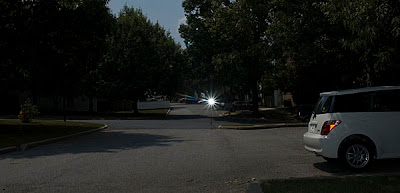Understanding and Using Optical Slaves, Pt. 1
 First off, this is a long-overdue post. It arguably could have been in Lighting 101. But this week (four-plus years later) we'll be looking at choosing and using optical slaves.
First off, this is a long-overdue post. It arguably could have been in Lighting 101. But this week (four-plus years later) we'll be looking at choosing and using optical slaves.In this post, how to figure out which kind is right for you.
__________
Only Two Things Matter
Slaves are not particularly complicated. They see a light pulse, and then they complete a circuit -- hopefully firing your second flash in the process.
There are only two variables that should concern you -- connectivity and sensitivity. (Okay, price, maybe. But as you'll see later, it is better to wait a little bit and buy a little further up the scale if you possibly can.)
Connectivity
How sensitive a slave is doesn't mean squat if it will not connect to your flash. Typical connectors are HH (meaning US-style household plug), 1/4" plug, 1/8" (3.5mm) plug, PC plug and specialized connectors such as the weird Vivitar thingie.
There are hot-shoe based slaves, too, but you will always pay a premium for them. Which is why the very first rule of slaves is to:
ALWAYS TRY TO CHOOSE FLASHES WITH BUILT-IN SLAVES.
Sorry for the all caps, but I do not even consider a flash unless it has a built-in slave. But if your flash hasn't got one, you'll have to choose a slave that will connect to it. And God help you if you have a series of flashes with different connectors. With decent slaves starting at north of $50, you can see how the necessary duplication could get expensive fast.
If you have 1/4" and 1/8" jacks on your flashes, you can solve the compatibility problem with a cheap adapter. Ditto getting to an HH jack, if you have a couple bucks and some soldering skills. But the most important point is that you should be considering the down-the-road costs when you are buying flashes. And buying a flash without a built-in slave or an external PC jack makes life complicated for you later.
Long story short, there is a lot of elegance in a flash system with a jack you can sync with low-cost cords and a built-in slave. That was the thinking behind the LP160 -- to duplicate the bigger monoblocs' ease of syncing.
Sensitivity
Once you have your slave hooked up to your flash, you are halfway home. Now you have to get it to actually fire.
This is where lots of people pay the newb tax -- when they buy a no-name eBay slave that technically fits their flash but fires about 30% of the time. (But hey! They're $10!)
There are two kinds of slave circuits -- passive and powered. The above eBay specials are almost always passive. And when they do work it will typically be in an indoor situation -- low ambient, lots of bounce surfaces, and for good measure you should probably throw in some pretty high master flash energy levels, too.
Passive slaves will typically advertise a range of ~100 feet. Take that with a grain of salt. It is calculated under ideal circumstances with powerful master flashes.
To be fair, there are decent passive slave designs. But they typically will be for short-range, bright flash situations. My advice is to save a little longer and opt for a powered design.
Trust me, you really want a powered slave. You'd think they'd require batteries -- and they used to. But a while back someone got the bright idea to use the voltage from the flash's trigger circuit to power the slave. Presto, no batts needed.
The range on a powered slave can be very impressive. You'll see advertised ranged of ~600 feet and up. Grain of salt there, too. But you can compare apples to apples from the same manufacturers to see which slaves they consider to be their best.
Take a look at this slave product range from Wein, who has a good reputation for high quality slaves. You'll see a wide range of connectors and sensitivities available.
How do you tell which ones are powered slaves, and thus more sensitive?
You'll see prefixes like "super" and "ultra" being batted about. And the prices will rise, too.
And "super" and "ultra" are not far from the truth. If you have problems with these slaves, it is more likely to be from false positives (random fires). These are likely not random at all, but rather triggers from environmental light pulses -- the sun gleaming off of a passing car, perhaps.
But the takeaway is that an expensive slave is usually worth the money.
Built-In is Better
 Here is a photo from a ways back, illustrating just how good the built-in slave is on a Nikon SB-800 when in SU-4 mode.
Here is a photo from a ways back, illustrating just how good the built-in slave is on a Nikon SB-800 when in SU-4 mode.Built-in slaves (more so the modern ones as opposed to the ones from 20 years ago) are almost always "super slaves." And the internal connectors are all soldered, which is better than any flavor of jack.
That photo was taken in the middle of the day. That flash was triggered by the internal slave seeing the on-camera speedlight. Impressive.
So if you are buying flashes, stick with those models with a well-regarded built-in slave. You'll save money in the long run, and you add a lot of versatility to your lighting schemes.
We'll talk about that -- and how to get the most out of your slave's range and sensitivity -- in Pt. 2.
__________
New to Strobist? Start here | Or jump right to Lighting 101
My new book: The Traveling Photograher's Manifesto
Permalink
<< Home